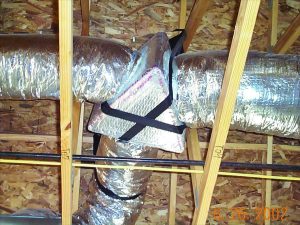Airflow. It’s in our ventilation sytems. It’s the media through which our weather works. Off the South-Eastern coast of the United States, bounded by Miami (in Florida), San Juan (in Puerto Rico), and the north-Atlantic island of Bermuda, is an area known as the Bermuda Triangle. For years many ships and planes inexplicably disappeared when they dared to venture into this region. They entered the Triangle, but never came out. They simply vanished. The world tells many legends about these disappearances.

Hundreds of boats and planes have been lost to the mysterious triangle. Click here for more about this phenomenon.
Did you know that the HVAC industry has its own Bermuda Triangle? It exists in residential attics across the country. Airflow in ducts simply disappears. Unlike the legend of the Bermuda Triangle, this triangle is easy to recognize and fix. Then, airflow that once vanished without a trace now reappears as if by magic.
On the other hand, the Bermuda Triangle of Airflow is commonly referred to as a remote duct board box fabricated in the shape of a triangle. Why does airflow that enters these triangles often disappear mysteriously? What can you do to correct this ‘devour-er’ of airflow? Let’s look at these fittings and see why they have the potential to reduce airflow.
Lost Airflow Through Duct-board Triangle History
The duct-board triangle is decades old and makes many attic installations a lot easier and quicker. These fittings are often field fabricated to match the flexible duct sizes attached to it. Some portions of the country have never seen these fittings while others use them daily.
Fitting Losses
When you look at the design values given to this type of fitting, they don’t appear to perform poorly. Some references have these fittings at an equivalent length of straight duct as long as 18 feet — not bad considering an offset in flex duct has the same amount of resistance. The equivalent length of the fitting isn’t the problem though — it’s what happens inside the fitting that causes air to get lost.
So these fittings have a large amount of pressure drop associated with them and they lack direction for airflow as it attempts to leave the fitting. This is mainly due to momentum loss in the fitting as air from the duct feeding the fitting expands into a much larger space. All air velocity diminishes inside the fitting.
In other words, air is lost due to excessive turbulence created by this effect. Air patterns disappear as entering airflow dead-heads into the walls of the fitting. This creates a spinning motion that causes airflow confusion – it doesn’t know where to go. Think about the racing game where opponents place their foreheads on the knob of a baseball bat, close their eyes, spin in circles, and then take off running after someone yells go. Get the idea?
Become a Lost Airflow Legend Killer
Scientist and explorers still try to solve the legend of the Bermuda Triangle, though few believe they can. The good news: you can solve issues associated with the Bermuda Triangle of Airflow today. Here’s how:
In place of these fittings, consider using extended plenums, lengthy transitions, or wyes. Therefore, the cost to install these corrections will be slightly more than the duct-board triangle, but the improvement in airflow performance will be noticeable immediately. How much more would your customers invest if they knew they could get air to the most uncomfortable rooms in their home?
What if they could “see” that air? Using a balancing hood makes the defects created by these fittings visible to your customers and makes it easy for them to visualize what is happening. Measured airflow values from a balancing hood are where the rubber meets the road. If your customers have low airflow to a room with these fittings, you can correct that. With a balancing hood you can show your customers the improvement you can make and give them confidence they are making the right decision.
David Richardson serves the HVAC industry as a Curriculum Developer and Trainer at the National Comfort Institute (NCI). NCI specializes in training focused on improving, measuring, and verifying HVAC and Building Performance.
Do you, as an HVAC contractor or technician, want to learn more about measuring airflow? Contact David at davidr@ncihvac.com or call him at 800-633-7058. NCI’s website, www.nationalcomfortinstitute.com, is full of free technical articles and downloads to help you improve your professionalism and strengthen your company.








Leave a Reply
You must be logged in to post a comment.